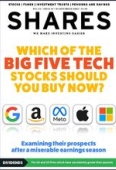Archived article
Please note that tax, investment, pension and ISA rules can change and the information and any views contained in this article may now be inaccurate.
Why supply chain issues aren't going away anytime soon

Hearing words like bottleneck, disruption and crisis in connection with global supply chains isn’t exactly new news but the fact those words are still being used by company bosses during the current third-quarter earnings season is still something worth considering by investors.
And it’s not sector specific, it’s not just about those semiconductors though that’s still a big issue for car makers like Renault (RNO:EPA); Nestle (NESN:SWX), Lockhead Martin (LMT:NYSE) and McCormick (MCK:NYSE) are just a few of the multinationals citing a ‘choppy’ supply chain when delivering their earnings updates.
ELECTRIC VEHICLE PROBLEMS
Electric vehicle (EV) production has been one of the biggest casualties with would-be owners waiting up to 18 months for high-end brands like Porsche’s (PAH3:ETR) Taycan but data out last month from Electrifying.com shows the average wait time for all drivers wanting to make the switch today is nine months.
Supply problems typically mean higher costs, a premium that has to come out of somebody’s pocket. After months of big brands being able to pass those hikes onto their consumer there are now questions about exactly how far that pricing power can stretch or, in the case of EVs, how long motorists are prepared to wait before ditching their green move entirely.
While the New York Fed’s Global Supply Chain Pressure Index shows a five-month decline and BMW (BMW:ETR) and European tech behemoth ASML (ASML:AMS) both mentioned that supply chains had begun to stabilise bringing improved margins, there’s still a long way to go to get back to historical levels and a whole host of issues to consider.
WHAT ABOUT CHINA?
Top of the list has to be China’s zero-Covid policy which looks likely to see more cities locked down and factories silenced. Apple’s already facing renewed problems with production of its latest iPhone after a fresh Covid scare garnered headlines with reports of workers fleeing the Foxconn (2354:TPE) factory in Zhengzhou City after public transport was suspended as part of new controls.
There’s also the ratcheting up of tensions in Ukraine as Russia battles to hold ground ahead of a brutal winter. The Kremlin’s decision to pull out of the Black Sea export deal which had ensured critical supplies made it out of Ukraine has already sent the price of some wholesale foods soaring adding to concerns about the impact of inflation on the most vulnerable. Wheat has been in short supply since the invasion began in February and the price of animal feed and items like sunflower oil have shot up in price heaping more misery on households right around the world.
Then there’s the potential fallout from US measures to curb China’s chip sector. The White House has put export measures in place that
limits the sale of advanced chips and chip making tools to the region in a bid to hamper China’s technology ambitions. And they won’t just impact China’s chip companies there are also plenty of discussion taking place in boardrooms right around the world about how the restrictions will impact future production.
Though notably Netherlands-based ASML said in its latest earnings update its shipments next year would only be impacted in a small way because it primarily provides more mature chip technology to China which isn’t affected by the moves.
INVENTORY ISSUES
One method of navigating supply challenges has been to up the amount of inventory held but that’s ended up causing its own issues. Pad too much and get stuck with the cost of storing merchandise or worse still get stuck with excess stock you can only get rid of at a loss. Walmart (WMT:NYSE) and ASOS (ASC) know all about that particular quandary. The US retailer had to slash prices in the summer after it was stuck with an oversupply of clothing and ASOS is turning to the high street to flog off it’s glut of out of season apparel.
Both businesses have unsettled investors with their predicament, caught out by the toxic mix of supply chain concerns and a consumer focused on cutting discretionary spend, an issue which is only expected to increase as the cost-of-living crisis erodes people’s purchasing power.
And even companies that managed to largely navigate 2021’s supply issues, like Tesla (TSLA:NASDAQ), are now having to face up to the fact that a huge chunk of people simply don’t have the ability to spend the way they’ve been able to in future years.
The electric car maker had been sitting pretty as competitors struggled with long lead times to get EVs to market giving them a significant window to corner an even bigger share of the market. But inflation is squeezing consumers budgets right around the globe and Tesla’s had to resort to lowering prices in order to secure sales in Asian markets.
And longer term supply chain management is something that all businesses need to think about. Globalisation took a big hit post covid and many producers have thought about those expensive and potentially disruptive trading miles and decided to take the uncertainty out of the equation. Onshoring manufacturing or sourcing suppliers closer to home, however this, in itself, comes with significant costs attached.
Important information:
These articles are provided by Shares magazine which is published by AJ Bell Media, a part of AJ Bell. Shares is not written by AJ Bell.
Shares is provided for your general information and use and is not a personal recommendation to invest. It is not intended to be relied upon by you in making or not making any investment decisions. The investments referred to in these articles will not be suitable for all investors. If in doubt please seek appropriate independent financial advice.
Investors acting on the information in these articles do so at their own risk and AJ Bell Media and its staff do not accept liability for losses suffered by investors as a result of their investment decisions.
Issue contents
Editor's View
Feature
Great Ideas
News
- Investors turn wary eye to Marks & Spencer and Primark-owner
- US inflation remains sticky, but some there are signs it could be peaking
- Halfords investors rejoice as the retailer’s share price finally starts to recover
- Why shares in On The Beach remain down in the dumps
- RELX and CentralNic stand out in latest batch of earnings upgrades and downgrades
- Lula stages remarkable political comeback to lead Brazil for a third term

 magazine
magazine








